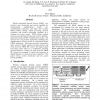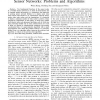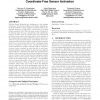901 search results - page 65 / 181 » Minimum power configuration in wireless sensor networks |
CACM
2000
13 years 8 months ago
2000
Wireless Integrated Network Sensors (WINS) now provide a new monitoring and control capability for transportation, manufacturing, health care, environmental monitoring, and safety...
INFOCOM
2007
IEEE
14 years 3 months ago
2007
IEEE
— Two fundamental functions of the sensor nodes in a wireless sensor network are to sense its environment and to transmit sensed information to a basestation. One approach to pro...
PERCOM
2005
ACM
14 years 8 months ago
2005
ACM
We propose a hybrid model to alleviate the notorious problem of premature battery depletion in sensor networks: in a first stage, simple sensors are deployed over an area of inter...
CORR
2010
Springer
13 years 8 months ago
2010
Springer
Wireless sensor networks are collections of large number of sensor nodes. The sensor nodes are featured with limited energy, computation and transmission power. Each node in the n...
MOBICOM
2009
ACM
14 years 3 months ago
2009
ACM
Wireless Sensor Networks are emerging as a key sensing technology, with diverse military and civilian applications. In these networks, a large number of sensors perform distribute...



